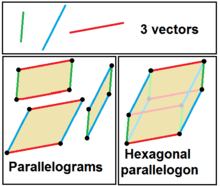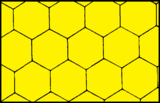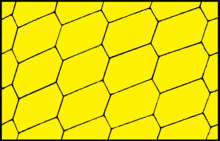Parallelogon


A parallelogon is a polygon such that images of the polygon under translations only tile the plane when fitted together along entire sides.[1]
A parallelogon must have an even number of sides and opposite sides must be equal in length and parallel (hence the name). A less obvious restriction is that a parallelogon can only have four or six sides;[1] a four-sided parallelogon is a parallelogram. In general a parallelogon has 180-degree rotational symmetry around its center.
Two polygonal types
Quadrilateral and hexagonal parallelogons each have varied geometric symmetric forms. In general they all have central inversion symmetry, order 2. Hexagonal parallelogons enable the possibility of nonconvex polygons.
| Sides | Examples | Name | Symmetry | |
|---|---|---|---|---|
| 4 | Parallelogram | Z2, order 2 | ||
| Rectangle & rhombus | Dih2, order 4 | |||
| Square | Dih4, order 8 | |||
| 6 |    | Elongated parallelogram | Z2, order 2 | |
| Elongated rhombus | Dih2, order 4 | |||
| Regular hexagon | Dih6, order 12 | |||
Geometric variations
Parallelogram can tile the plane as a distorted square tiling while hexagonal parallelogon can tiling the plane as a distorted regular hexagonal tiling.
| 1 length | 2 lengths | ||
|---|---|---|---|
| Right | Skew | Right | Skew |
 Square p4m (*442) |
 Rhombus cmm (2*22) |
 Rectangle pmm (*2222) |
 Parallelogram p2 (2222) |
| 1 length | 2 lengths | 3 lengths | ||
|---|---|---|---|---|
 |
 |
 |
 |
 |
| Regular hexagon p6m (*632) |
Elongated rhombus cmm (2*22) |
Elongated parallelogram p2 (2222) | ||
See also
- Parallelohedron - Dimensional extension of parallelogons into 3D
References
- The facts on file: Geometry handbook, Catherine A. Gorini, 2003, ISBN 0-8160-4875-4, p.117
- Grünbaum, Branko ; and Shephard, G. C. (1987). Tilings and Patterns. New York: W. H. Freeman. ISBN 0-7167-1193-1. list of 107 isohedral tilings, p.473-481
- Fedorov's Five Parallelohedra